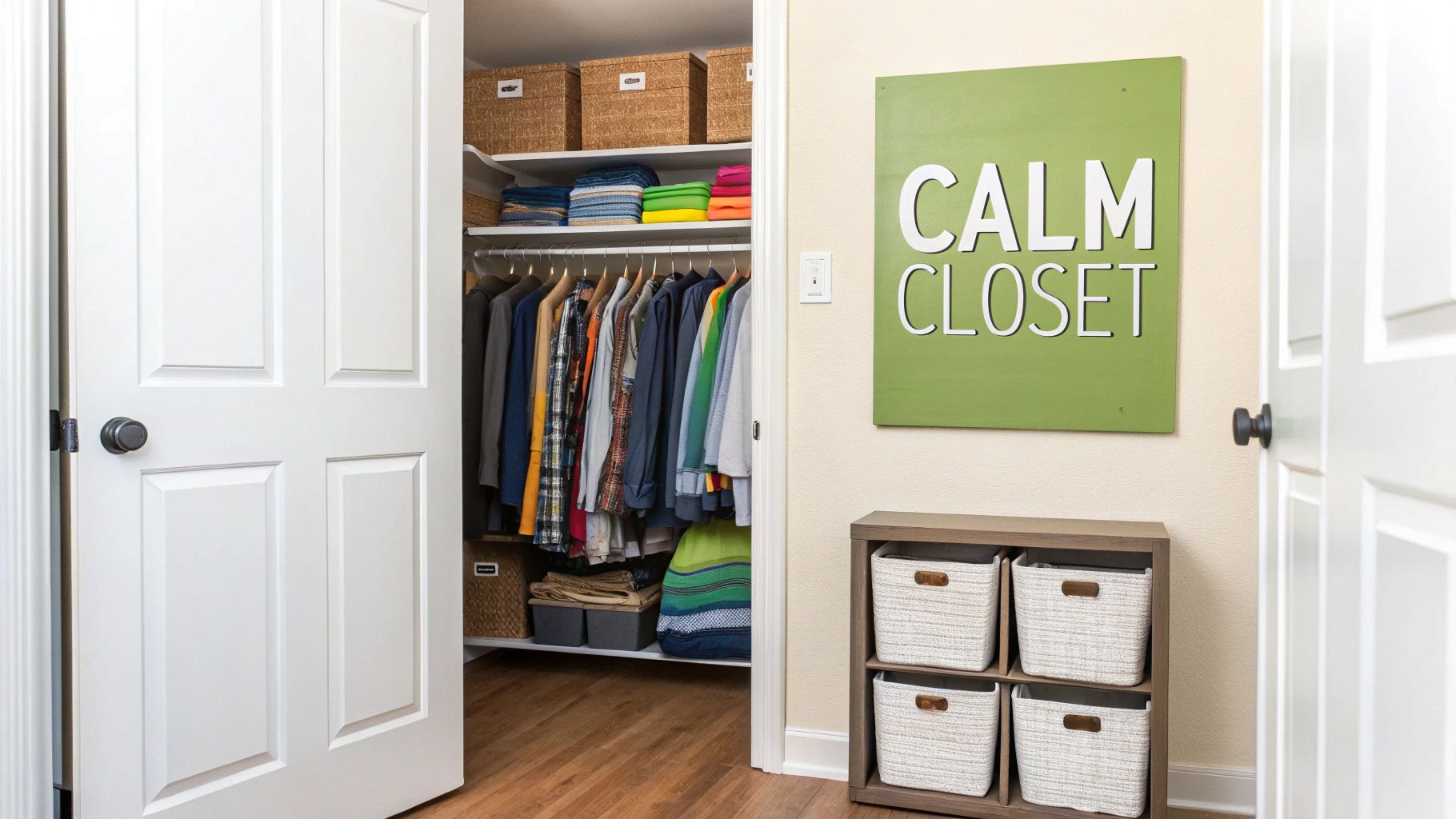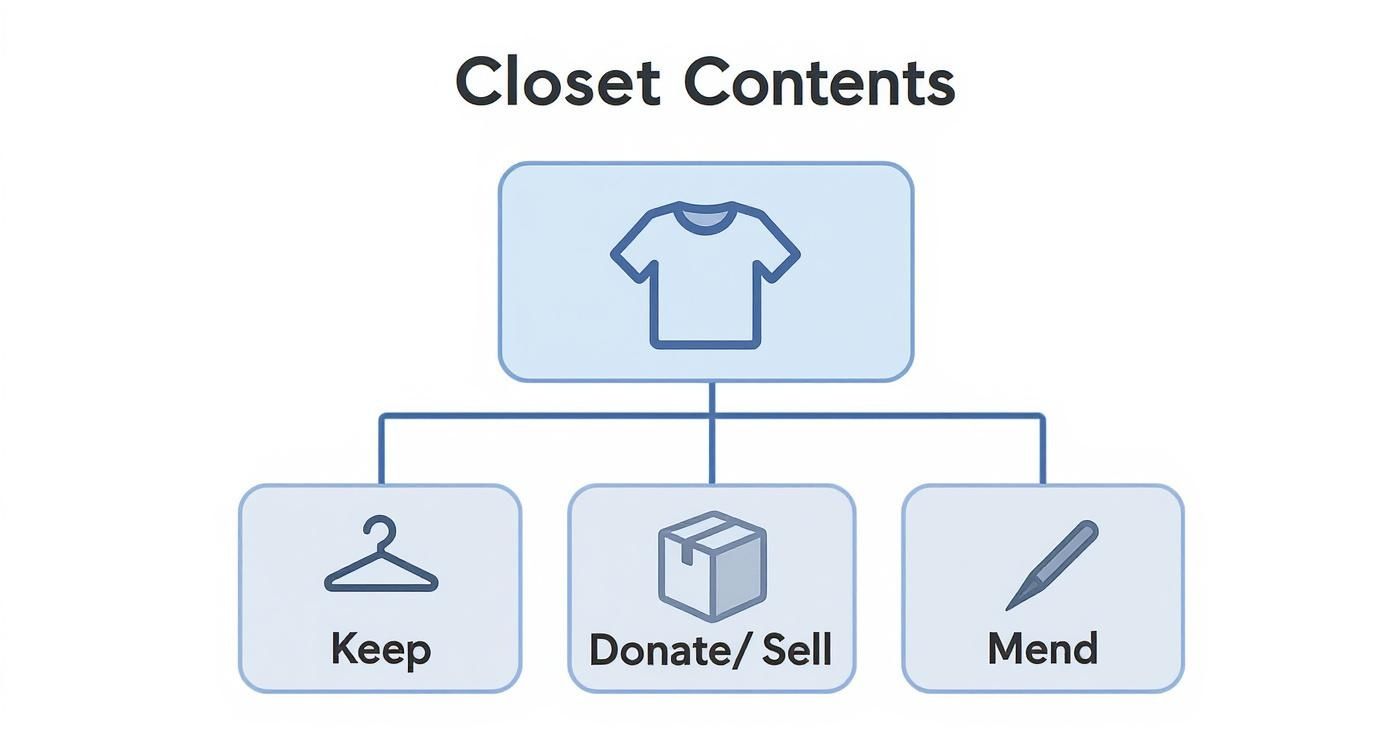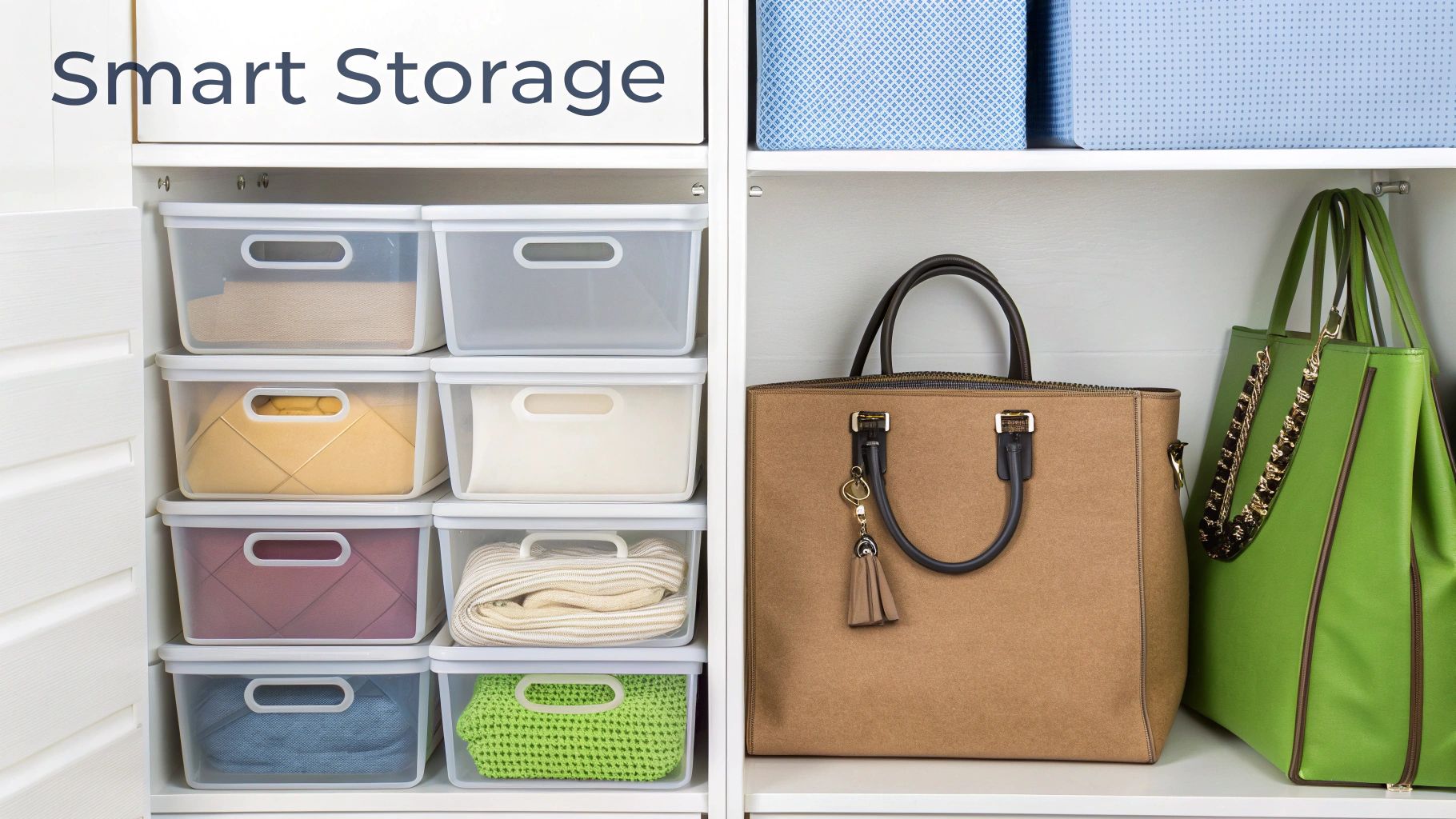Maximizing Small Closet Space: A Guide to Strategic Organization

Wrestling with a chaotic, overflowing closet is a frustrating way to start the day. It adds a layer of stress we just don't need. The real secret to mastering a small closet isn't a one-time cleanup; it’s about building a simple, sustainable organization system that actually works for your life. Forget the temporary fixes—we're going to lay out a foundational strategy to turn that cluttered space into a functional, organized wardrobe.
Transform Your Small Closet From Chaos to Calm

We've all been there. Staring into a closet that feels more like a storage unit than a wardrobe. It’s a common frustration, especially as our collections grow over the years without a real plan. This isn't just about tidying up. It's about creating an intuitive home for everything you own, making your daily routine feel less like a chore and more like a choice.
A well-organized closet sets the tone for the rest of your day. Imagine starting your morning with a sense of calm instead of a frantic search for that one elusive shirt. To get you there, I'm going to walk you through a powerful four-pillar strategy for lasting closet organization: Purge, Zone, Visualize, and Optimize. Together, they bring lasting order to any wardrobe, big or small.
The Four Pillars of Small Closet Organization
To make this whole process feel less daunting, I've broken it down into a simple framework. This isn't about achieving Instagram-perfect results overnight; it's about making real, noticeable progress. Each pillar builds on the one before it, giving you a complete approach to reclaiming your space for good.
It's no surprise that people are looking for better solutions. The global wardrobe market was valued at a staggering USD 66.31 billion in 2024 and is projected to hit USD 108 billion by 2032. That growth is fueled by smart innovations like pull-out drawers and adjustable shelving—features designed for modern homeowners trying to make the most of limited square footage. With home renovations on the rise and more people living in compact urban spaces, optimizing our closets has become a necessity.
A well-organized closet isn't a luxury; it's a tool for a more efficient and less stressful life. By giving every item a home, you give yourself more time and mental clarity each day.
To truly take your space from chaotic to calm, it helps to zoom out a bit. Embracing the bigger picture of downsizing and decluttering strategies for a simpler life can be incredibly powerful. A tidy closet is the first step toward a more organized life.
Before we get into the nitty-gritty, this table gives a quick snapshot of the core principles. Think of it as your roadmap—a simple guide to make the entire process feel clear and manageable right from the start.
The Four Pillars of Small Closet Organization
Here's a quick look at the core strategies we'll be using to reclaim your closet space. This table is a handy reference for the key steps involved in our journey.
| Pillar | Action | Primary Goal |
|---|---|---|
| Purge | Decisively remove items you no longer need, wear, or love. | To create a foundation by working only with essential items. |
| Zone | Group similar items together into logical categories. | To establish an intuitive system for finding and storing clothes. |
| Visualize | Arrange items so you can see everything you own at a glance. | To reduce forgotten items and make getting dressed easier. |
| Optimize | Use smart tools and techniques to maximize every inch of space. | To ensure the closet functions efficiently for the long term. |
With this framework in mind, you're ready to tackle the closet with a clear, actionable plan.
The Decisive Decluttering Method
Real closet organization begins with a focused purge. Before you can arrange anything, you must first create space by deciding what actually deserves to be there. This isn't just about cramming more stuff into clever storage; it's about curating your wardrobe.
The mission is simple: every single item in your closet should be something you genuinely love, use, and feel great wearing. Everything else is just clutter taking up precious real estate. Clearing it out not only frees up physical space but also mental space, making your morning routine so much simpler.
Figuring Out What Stays and What Goes
A fantastic, low-effort way to start is with the Reverse Hanger Trick. Go into your closet right now and turn every hanger so the hook faces out, towards you. After you wear something, put it back with the hanger facing the normal way.
In six months, you’ll have a brutally honest visual of what you actually wear. It's a simple reality check on your wardrobe habits, providing clear data for your organizational efforts.
For the items you're still on the fence about, ask yourself a few tough questions. Does this fit me today? Not "someday," but right now. Is it comfortable and in good shape? Do I have a real occasion to wear this in the next year? Hesitation is often a sign to let go. For a more detailed walkthrough, our guide on how to declutter your closet has even more strategies to help you make those tough calls.
The Four-Pile Sort
To maintain focus, sort every single piece of clothing into one of four piles. This forces you to make a clear decision on every item, avoiding that dreaded "maybe" pile that ends up back in the closet. Grab some boxes or laundry baskets before you start.
- Keep: These are your non-negotiables. You love them, you wear them, and they fit your life right now. These are the items you will organize.
- Donate: Perfectly good clothes that just aren't you anymore. Bag them up and put them in your car immediately for your next trip out. Out of sight, out of mind.
- Sell: Items that are still in great shape and have some resale value. Get them listed on Poshmark or Depop right away to keep the momentum going.
- Mend: That shirt with the missing button or the pants that need hemming. Create a dedicated mending basket, but give yourself a firm deadline—say, two weeks—to get it done.
I get it—letting go can feel wasteful. Reframe it: You aren't losing an old shirt; you're gaining a well-organized closet filled only with clothes that make you feel confident.
Once you’ve done the hard work, use the Container Method to keep clutter from creeping back in. Assign specific drawers or bins for things like workout clothes or sweaters. The rule is simple: if the container is full, you can’t add anything new until you take something out. It’s a game-changer for maintaining your hard-won organization for good.
Unlocking Vertical Space to Double Your Storage
Alright, you’ve decluttered. Your closet now only holds the clothes you actually love and wear. Now, the real organization begins. Most of us instinctively think horizontally—we see the closet rod, the shelf, and the floor. But the secret to truly conquering a small closet lies in looking up. Vertical real estate is your most valuable, and most overlooked, organizational asset.
When you start seeing your closet in terms of its full height, not just its footprint, you can genuinely double your storage without calling a contractor. It's about making every single inch, from floor to ceiling, an active part of your organization system.
Think Like an Architect, Not a Stacker
We've all been there: stacking sweaters on a high shelf until they create an inevitable avalanche. It’s time to stop stacking and start strategizing. Think of yourself as an architect designing a functional space.
Those high, hard-to-reach shelves are perfect for off-season items. Bulky winter coats, sundresses, or vacation-only clothes can go into clear, labeled bins. This keeps them dust-free and lets you see what you've stored without needing to pull everything down.
This simple move frees up the prime real estate—the stuff at eye level and within easy reach—for the clothes you wear every day. This need for smarter storage is huge; the global closet organizer market was valued between USD 6.2 billion and USD 7.6 billion in 2024. As our living spaces get smaller, we're all looking for smarter ways to organize.
Double Your Hanging Space Instantly
One of the quickest wins in any closet organization project is to add a second hanging rod. If you have a standard single-rod setup, look at all that empty air below your shirts and jackets. You can reclaim that space in minutes with a tension rod or a hanging closet doubler.
Don't underestimate the power of simple additions. A single tension rod can literally double your usable hanging space, transforming a crowded closet into a well-organized wardrobe overnight.
This is my go-to trick for zoning. I use the top rod for shirts and blouses and the bottom for skirts or folded pants. It makes finding specific items so much faster. If you want to see exactly how to do it, we've got a whole guide on how to install a double closet rod that walks you through it.
Another fantastic tool is the cascading hanger. These hangers let you group outfits or categories of clothing—like pants, skirts, or tank tops—in a vertical line, using just one spot on your closet rod. It's an incredible space-saver.
Before you get started, this visual breakdown is a great reminder of how to sort everything first.

This process ensures you're only organizing the things that truly belong in your closet.
Finally, don't forget the door! An over-the-door organizer is a game-changer for shoes, scarves, belts, and other accessories. It uses a surface that's almost always ignored, getting all those small, clutter-prone items up off the floor and into their own designated spots.
Choosing Smart Storage Solutions

So, you’ve mastered vertical space. What's next? It's time to give everything else a logical, designated home. This is where smart storage solutions really shine, especially for all those smaller items that tend to cause the most chaos—shoes, accessories, and folded clothes.
The key here is thoughtful containment. It's not about just grabbing a bunch of random bins and hoping for the best. It’s about picking the right tool for each job, because the right containers are essential for an organized closet.
Bins, Boxes, and Dividers
Let's start with the things you grab every day. For these, clear bins are an absolute game-changer. Seeing what's inside at a glance means no more frantic digging through neatly folded piles just to find what you need. This makes maintaining your organization effortless.
For items you don’t use as often—think seasonal scarves or sentimental keepsakes—fabric boxes are a fantastic option. They tuck away nicely on a high shelf, hiding the visual clutter and giving your closet a much calmer, more uniform look.
The real test of any storage solution is whether it makes your life easier. If you have to pull down three different mystery boxes just to find a single belt, your system has failed.
And don't even get me started on drawer dividers—they're a non-negotiable for anyone serious about organizing a small closet. They're lifesavers for taming socks, underwear, and belts. By creating simple, individual compartments, they stop your drawers from turning into a jumbled mess and ensure every item has its place.
Creative Hacks for Awkward Items
Accessories are notorious for being the hardest things to organize. Handbags, clutches, and belts just don't stack well, and they can easily end up in a messy pile on the floor or a shelf.
Here are a few organizational tricks I’ve picked up over the years:
- S-Hooks for Handbags: Grab some simple S-hooks and hang your purses from the closet rod. It keeps them visible, accessible, and helps them keep their shape.
- Magazine Files for Clutches: That standard office magazine file on your desk? It’s the perfect size for storing small clutches upright on a shelf.
- Tension Rods for Scarves: Add a small tension rod between a shelf and the closet wall. You can loop your scarves over it, which keeps them visible and wrinkle-free.
It's no surprise that the custom closets market hit about USD 29.3 billion in 2023 and is expected to soar to USD 55.2 billion by 2032. We're all craving smarter, more personalized solutions for our unique spaces.
A great way to get inspired is to think about the techniques for packing clothes like a pro; those strategies for condensing items are pure gold for closet organization. Finding the right mix of tools is everything, and our guide on the best closet organizer systems can point you toward even more great ideas for your space.
Keeping Your Closet Organized for the Long Haul
You’ve done the hard work—the purging, the sorting, the optimizing. Your closet is organized. But here’s the thing I've learned from years of organizing spaces: getting it clean is one thing, but keeping it that way is the real win. This last part is all about creating simple habits that maintain the system you've built.
The best organizational systems are the ones you can actually stick with. We're not aiming for another marathon cleaning session in six months. The goal is to build a few effortless routines that keep the chaos from creeping back in.
Adopt the "One In, One Out" Mentality
This is probably the single most effective habit you can build for a clutter-free, organized closet. The "one in, one out" rule is exactly what it sounds like: every time you buy something new, something old has to go. It's a game-changer.
Think about it. That new dress you just couldn't resist? Great, now pick one you haven't worn in a year to donate. Scored a fresh pair of sneakers? Awesome, an older pair gets retired. This simple transaction keeps your wardrobe from overflowing and makes you think twice about impulse buys, ensuring your organized space stays that way.
The Power of the 10-Minute Weekly Tidy
Life happens. Clothes end up on "the chair" instead of a hanger. It's normal. The trick is not letting it snowball. My secret weapon is the 10-minute weekly reset. Seriously, just ten minutes.
Pick a time—Sunday evening is great for this—and just blitz the closet.
- Put stray clothes back in their designated spots.
- Re-hang anything that’s slipped off.
- Straighten up your shoe collection.
- Quickly refold any stacks that have gotten messy.
This isn’t a full-blown reorganization. It’s quick, routine maintenance. A little bit of consistent effort prevents you from ever facing a closet avalanche again.
Make the Seasonal Swap Your Friend
If you live somewhere with actual seasons, rotating your wardrobe is a non-negotiable organizational habit. Why let your bulky winter sweaters crowd out your breezy summer tops in July? Stashing off-season clothes frees up an incredible amount of prime real estate in your closet.
Twice a year, set aside an hour or two. Box up the clothes you won't be touching for the next few months—under-bed containers or those vacuum-sealed bags work wonders for this. As you pack things away, give them a quick once-over. Anything you didn't wear at all last season? That's a strong sign it might be time to let it go. This process becomes a built-in decluttering session that keeps your closet curated and ready for whatever the weather brings.
Answering Your Toughest Closet Questions
Even with a solid plan, you're bound to hit a few snags when wrangling a small closet into shape. Don't worry, it happens to everyone. Getting past these common hurdles is the last piece of the puzzle. Let's tackle some of the most common organizational questions.
Think of this as your personal troubleshooting guide. Nailing these little details is what will make your new system stick for the long haul, keeping your closet a stress-free zone.
How Can I Store Bulky Items Without Losing All My Space?
Ah, the classic dilemma: bulky sweaters and winter coats. They're the biggest space-eaters in any wardrobe. The secret here is seasonal organization.
For anything you won't be wearing for the next few months, vacuum-sealed bags are a game-changer. They can shrink a massive pile of sweaters down to a slim, manageable package that can be stored elsewhere.
Once sealed, just slide them onto that top shelf or under the bed. They’ll be out of sight and out of mind, instantly freeing up precious rod space for in-season items. For the coats you are using, group them together on sturdy hangers in one section of your closet so they aren't squishing your lighter clothes.
What’s the Best Way to Organize Shoes?
Shoes are often the main culprit behind closet floor chaos. The best organizational strategy is to go vertical. An over-the-door shoe organizer is probably the single most effective trick in the book—it uses space that is almost always completely ignored.
If the back of your door isn't an option, a slim, tiered shoe rack can work wonders on the floor without taking up much real estate. For those who want to keep their shoes pristine and organized, clear, stackable shoe boxes are a fantastic solution. You can see everything at a glance, which means no more digging through a mountain of mismatched pairs to find the ones you want.
The goal with shoe storage isn't just to get them off the floor—it's to create a system where finding and putting away your shoes takes zero effort. Ease of use is what makes an organization system last.
My Closet Has No Shelves. What Are My Options?
A closet with no shelves or drawers might feel like a problem, but I see it as a perfect blank canvas. You get to build an organization system that works exactly for you.
Here are a few of my go-to solutions that don't require a single tool:
- Freestanding Shelving: Tuck a narrow, freestanding shelving unit against one wall. It instantly gives you a spot for folded sweaters, bins, and accessories.
- Hanging Organizers: Those fabric organizers with cubbies that hang right from the rod are a lifesaver. They're brilliant for creating makeshift shelves for t-shirts or workout clothes.
- Tension Rods: This is one of my favorite renter-friendly hacks. Add a second tension rod below your main one to double your hanging space for pants or skirts in seconds.
- Stackable Drawers: A set of simple plastic or fabric drawers on the floor can create a mini-dresser inside your closet for socks, underwear, and other small items.
With these simple additions, you can build all the structure you need without making any permanent changes.
Ready to reclaim your closet for good? Having the right tools is half the battle. MORALVE specializes in brilliantly designed space-saving hangers that can instantly multiply your closet space and create a sense of order.
Check out our collection of smart, functional hangers and start your journey to a beautifully organized closet today at https://moralve.com.


Leave a comment